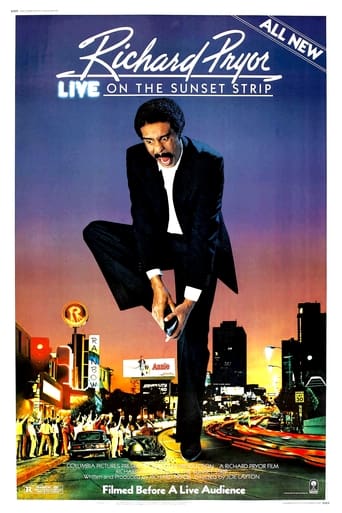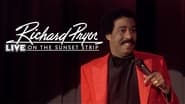videorama-759-859391
In his second most successful concert movie, again we brace ourselves for what magical dynamic stuff that will spout out of the mouth of an undying and legendary comic, who was pure genius. He cuts the surface of truth with his jokes, which makes so funny. The height of laughs for me, was when he was talking about the mafia. We've guaranteed ongoing laughs here, with new original material, where if your anti swearing, again take a rain check. Again 78 minutes passes by easy in another engrossing night of comedy, where our priceless Pryor tells those lengthy stories where that and vulgarity blend so well, where truths are told in funny and inventive scenarios, wonderfully written, where laughter just has us. No there never has been, or never will be, someone so sharp and cutting, or brilliant, like our Richard. Another concert movie success, in the city of Angels.
gavin6942
Richard Pryor performs his stand-up comedy act on the Sunset Strip. This shows us the benefit of editing two performances together -- we get the best of two shows, making it better than seeing either one of them live.Pryor has a vulgar routine on sex, and how showbiz has the perk of more women, including one night with an unnamed Playboy Bunny. We hear how Africa has black people that are actually black (suggesting that American black people are not completely black).We get a great story on how he worked in a Mafia night club in Youngstown, Ohio with stripper Satin Doll, and how "crime don't pay". (Unfortunately, he again does not name names.)Most striking of all, though, is his frank discussion of cocaine use. Not regretful, he tells it like it is (or was).
Steve Bailey
How do you top your own legend? In Richard Pryor "Live on the Sunset Strip" (1982), Pryor doesn't quite make it -- but he comes awfully close.A bit of background for the uninitiated: Pryor, already a huge success via his earthy 1970's comedy albums, made film history with "Richard Pryor Live in Concert." A modestly filmed recording of a 1979 concert he did in Long Beach, CA., it put many of that year's Hollywood blockbusters to shame with its rich characterizations and incisiveness; countless comics still cite it as their impetus for doing comedy.Unfortunately, Pryor was a volatile man with a severe drug habit. About a year after the concert film was released, Pryor was freebasing and caught himself on fire. (He later acknowledged it as a suicide attempt.) Therapy and cosmetic surgery helped to restore him, but it left him with a quandary: How does a comic whose act was based on fear and hostility acknowledge the love and support of his audience? Unlike its ground-breaking predecessor, the '82 film takes a while to get going. The credits, as simple as they are (Pryor produced the film and wrote the material), seem to last forever. And there's more longeur when Pryor makes his way to the stage via the audience, who can't stop their standing ovation and glad-handing of him.When he does finally reach the spotlight, Pryor appears a bit unsettled at first. The '79 film showed Pryor prowling the stage, his shirt visibly drenched in perspiration. In "Sunset Strip," he's dressed nattily in a flaming red suit -- ostensibly intended as a visual pun on his fire incident, but so spiffy that even he acknowledges that it ill-suits him. He initially throws out random observations, hoping something will stick.He finally hits his stride in a riff about male-female relationships, both casual (his encounter with a Playboy Bunny who gets turned on when Pryor does kiddie voices) and emotional (he tearfully calls up a recently estranged girlfriend who coolly advises him, "Don't do this to yourself"). He also hits pay dirt with his account of filming the 1980 comedy "Stir Crazy" at the Arizona State Penitentiary; at first he is moved by the plight of his black "brothers" until he is apprised of their graphic crimes, at which point he declares, "Thank God...we got...penitentiaries!" He also does a great routine about a recent visit to Africa, in which he imitates jungle animals in the manner of the menagerie of impersonations in his '79 film. After this, he begins to soften, as he realizes that his homeland visit has caused him to forever negate his use of the notorious N-word. He follows this with what he claims is "the final appearance" of his street character Mudbone (Pryor lied; he revived the character in his third concert film), who chides his creator Pryor for his fire incident. Critic Pauline Kael was put off by these passages, saying in essence that Pryor was kissing up to his audience with these observations. She might have been on to something, but considering that this comic narrowly escaped death and found some lacerating revelations on the other side, perhaps he was entitled to a little self-indulgence.All of this, naturally, leads to the movie's showpiece: Pryor's account of his 1980 immolation. He prefaces it with a joke about how it "really" happened: When he had milk and cookies in bed one night, he mixed whole milk with skim milk, "and the s*** blew up!" But when he launches into the true account of the events leading up to and following the fire, he pulls no punches. His gift for bringing inanimate objects to life gets downright eerie when he does the voice of his reassuring freebase pipe, which he came to regard as his only true friend. When I saw this movie upon its initial release, I sat open-mouthed at this routine, unable to laugh -- but not because it was poorly done. On the contrary, it was so forthright and honest that it went beyond comedy, to a point where you could imagine Pryor observing his self-destructive behavior from outside of himself. (Indeed, that was the approach Pryor took when he dramatized the incident in his autobiographical 1986 movie "Jo Jo Dancer, Your Life Is Calling.") Pryor lived for over two decades after this movie, until multiple sclerosis permanently stilled his demons. But in 1982, "Richard Pryor Live on the Sunset Strip" inspired well-earned laughter as well as gratitude that a rich talent such as Pryor was still with us. The movie still stands as a remarkable comedic document -- not quite as great as its '79 predecessor, but still head and shoulders above most of the brain-dead comedy from then and now.
tavm
Having just watched Richard Pryor: Live in Concert yesterday, I was very much looking forward to this, his next concert film. Quite hilarious when talking about sex, his experiences with the mafia, white people looking for humans like them in black Africa, and how women seem so calm compared to men like him. There's also some poignant stories about his trip to Africa and his resolving to never use the N-word again for humorous purposes compared to some of his past work. And then there's the freebasing/fire incident that concludes this film. His talk about Jim Brown and Brown's attempting to rehabilitate him is perhaps the most touching of the stories but that doesn't mean it doesn't end on a good laugh especially when it concerns his member. But while I liked most of what he did, I have to admit I wasn't too crazy about his "Mudbone" routine even though it was a favorite of an audience member who requested it. Still, while this wasn't as good as RP:LIC, Richard Pryor Live on the Sunset Strip still has many brilliant moments that make this well worth seeing.







